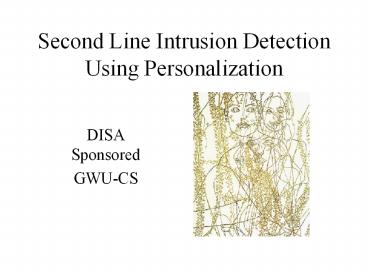Second Line Intrusion Detection Using Personalization - PowerPoint PPT Presentation
Title:
Second Line Intrusion Detection Using Personalization
Description:
No reason to assume that this level of 'insecurity' will change ... Construct input benchmarks. Continue work on Other Types of Entry Modes. More to come ... – PowerPoint PPT presentation
Number of Views:24
Avg rating:3.0/5.0
Title: Second Line Intrusion Detection Using Personalization
1
Second Line Intrusion DetectionUsing
Personalization
- DISA Sponsored
- GWU-CS
2
Content
- Introduction
- Examples and Analysis
- Prototype Design
- More to come
- Conclusion
3
Introduction
- Penetration into computer systems continues at a
high rate despite substantial progress in
security research and technology - No reason to assume that this level of
insecurity will change - Most penetrations are done by individuals or
small teams - Only lately has personalization entered into
security consideration
4
- Our research into personalization in areas such
as - User command lines behavior (e.g., UNIX)
- User browser patterns as reflected by URL
sequences - User work habits
- Provides a basis for
- User classification
- Abnormality observation
- Detection of deviation from regular behavior
- Changes in patterns
5
Examples and Analysis
- www.fada.com
- www.fada.com/address.html
- www.fada.com/cline.html
- www.fada.com/cline-bisttram.html
- www.fada.com/cline-stella2.html
- www.fada.com/karges.html
- www.fada.com/karges1.html
- www.fada.com/karges3.html
- www.fada.com/karges8.html
- www.fada.com/mmfa.html
- www.fada.com/mmfa1.html
- www.fada.com/mmfa9.html
6
Comments on Example 1
- Assumptions
- Access to server is through home page
www.fada.com - Knowledge of structure and content of server
pages www.fada.com - Provides the following
- Detailed access starts from server page
address.html - Page cline.html leads to two links
- Cline-bisttrom.html and
- Cline-stella.html
- The example demonstrates reasonable behavior
7
Example 2
- www.fada.com/mmfa9.html
- www.fada.com/rehs10.html
- www.fada.com/stern3.html
- www.fada.com/address.html
- www.fada.com/trotter41.html
- www.fada.com/cantor8.html
8
Comments on Example 2
- Access starts straight from a couple of internal
pages (i.e., nodes of the tree) - It continues by a visit to a link off the home
page - Summary
- The behavior does not follow regular access
patterns - The behavior is difficult to explain
- This access may indicate suspicious behavior
9
Other Types of Entry Modes
- In addition to URLs, one should watch out for
- FTP access
- Potential Logins
- Other protocols access e.g., port scanning
- On a sound server
- FTPs port are predefined
- E-mail, except for bugs, can be protected against
- Port scanning is already trapped by IDS
10
Prototype Design
- We face suspicious behavior with two tools
- Automatic recognition
- Machine Learning
- Data Mining
- Automatic recognition may be trained on regular
access patterns and attempt detection of
irregular access patterns - So far, results are good, but not great enough
penetration is undetected
11
Behavior Analysis Application
- A JAVA application that classifies behavior is
partially done and operational - It shows a high level of detection of irregular
behavior - The approach is promising and has a proven track
record - Web Browser communication performance improved by
20 by changing cache to use Next URL Prediction - Prediction is based on the underlining assumption
of regularity of behavior
12
Observation
- URL, IP packets, and Port scanning look like an
algorithm (or a program) without termination - Example 1 can be written as
- Initialize www.fada.com
- Initialize www.fada.com/address.html
- Loop rest of URLs
- The loop is a while that selects links in
www.fada.com/address.html for viewing - The selection criterion is personal
- Example 2 seems as an unordered set of program
statements - Therefore Example 2 does not seem to be a
regular access pattern
13
Prototype Design Details
- STEPS
- Analyze Server pages hierarchy
- Analyze each page for links and sources (i.e.
src) files - Build an identification engine based on
- Behavior categorization
- Page hierarchy
- Isolation of individual users to identifying
agents - Construct input benchmarks
- Continue work on Other Types of Entry Modes
14
More to come
- Examples of more complex relationships to be
explored - Server pages link to other servers pages
- Same source (IP) for different communication
types - Accessing different locations on tree
concurrently - Can be done by using two copies of the browser
- The two sessions will have different Ids but may
be cooperating - The agents monitoring the two browsers must
collaborate - URLs and FTPs from same source at the same time
- Multiple FTPs
- Similar case to multiple browsers
- ...
15
Conclusion
- A substantial prototype will be completed by end
of Summer - Complex relationships will be explored
- Threats will be enumerated
- Potential detection will be proposed
- Prototype will include some of these results
- Open areas will be reported on in detail































